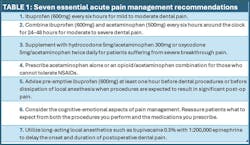From pain relief to practice success: Ethical, effective dental pain management
Key Highlights
- Implementing gentle techniques like painless injections and reassuring communication can significantly improve patient experiences.
- NSAIDs, especially ibuprofen, are as effective or more effective than opioids for dental pain, with fewer risks and side effects.
- Combining ibuprofen with acetaminophen provides superior analgesia, reducing the need for opioids and enhancing patient satisfaction.
- Pre-emptive NSAID therapy before procedures can decrease post-treatment discomfort and inflammation.
- Focusing on internal marketing, such as empathy and concern, fosters patient loyalty and encourages referrals, supporting practice growth.
Dental pain management has been called “the holy grail of patient satisfaction.” Dentists know that minimizing discomfort often results in more patients following through with treatment plans and referring loved ones—the lifeblood of any successful dental practice. Certainly, dentists could spend more money on advertising and marketing to enhance new-patient flow, however implementing a few simple pain-management techniques for your existing patient base will really benefit your bottom line.
The impact of patient satisfaction in dentistry
Many practice management courses offer a variety of marketing ideas. Some focus on external marketing such as mailings, coupons, print, and social media advertising. However, the courses that made the most sense to me were focused on aspects of internal marketing, such as empathy, compassion, concern, and attention to your existing patient base to enhance referrals.
Dentists spend years developing skills that demand incredible attention to detail: perfect crown margins, properly placed implants, root canals obturated to the correct working distance, etc. As highly trained professionals, we all appreciate the effort and conformity to standards of care. Conversely, most patients aren’t able to clinically evaluate the quality of care provided, and they judge dental professionals on a more emotional level. Do we care, do we listen, do we cause pain?
There are many elements that make up effective dental pain management. A painless injection, a gentle touch, a reassuring tone, and communicating expectations all go a long way toward how patients react to pain. A few simple evidence-based dental pain management strategies can simultaneously minimize dental pain and significantly reduce the need for opioids.
Dental pain management standards have gone through a substantial paradigm shift since the beginning of the prescription opioid crisis in the late 1990s. Dentists practicing before this time were trained to prescribe hydrocodone or oxycodone with acetaminophen not only after third molar extractions, but even for procedures that typically generate less pain. Such medications have been prescribed for decades, not because they are supported by good clinical studies, but because their use has been incorporated into our training. In fact, there are no clinical studies to support the belief that these opioid formulations are any more effective analgesics than ibuprofen or acetaminophen, alone or in combination.1
NSAIDs vs. opioids in dentistry
Hydrocodone or oxycodone and acetaminophen combinations got a foothold as the go-to analgesics for acute dental pain because NSAIDs (nonsteroidal anti-inflammatory drugs) were not introduced into mainstream pain management until the early1980s. Prior to the ‘80s, opioids were the drug of choice for acute dental pain because the effectiveness of NSAIDs was not yet apparent.2,3
Even after dentists began to understand the therapeutic benefits of NSAIDs, some practitioners were hesitant to switch to nonopioid dental analgesics for fear of being perceived by patients as uncaring for not prescribing the “stronger” prescription analgesics.4,5 Since the rise of social media, the fear of a bad review has only intensified.
Research on the analgesic efficacy of acute dental pain overwhelmingly concludes that the use of NSAIDs, alone or in combination with acetaminophen, are as or more effective analgesics than opioids with or without NSAIDs or acetaminophen.6–8 The following are simple therapeutic suggestions and techniques that, when implemented, will help minimize dental pain and maximize patient satisfaction in dentistry:
Ibuprofen
One of the safest, most predictable of the NSAIDs, ibuprofen has an analgesic ceiling of 400mg. That means that prescribing more than 400mg will not provide additional analgesic efficacy. Ibuprofen, however, has much more powerful analgesic versus anti-inflammatory efficacy, and as dentists, we understand that most dental discomfort involves some inflammatory component.9 It is recommended to prescribe 600mg every six hours around the clock for the first 24–48 hours of mild to moderate dental pain for maximum anti-inflammatory efficacy.10,11
Ibuprofen and acetaminophen combined
Studies have shown that taking ibuprofen and acetaminophen together provides analgesic efficacy greater than either medication alone, even surpassing the efficacy of opioids.4,12 Prescribing 600mg of ibuprofen taken with 500mg of acetaminophen every six hours around the clock for the first 24–48 hours will provide excellent analgesia for moderate to severe dental pain.13 This regimen provides the effective daily dose of ibuprofen—2,400mg— along with 2,000mg of acetaminophen, well under the 3,000–4,000mg daily hepatoxic ceiling concern. It is important to be cognizant of the hepatotoxic ceiling because of the hundreds of over-the-counter cough and cold mediations containing acetaminophen that patients may be consuming concurrently and unknowingly. Prescribing 2,000mg of acetaminophen within each 24-hour period also provides you with the option to safely prescribe, if necessary, an opioid/acetaminophen combination a few times a day for those cases of severe breakthrough dental pain.13
Pre-emptive therapy
When possible, prescribe NSAIDs prior to the onset of pain and inflammation, or alternately, before the anesthesia dissipates. Studies have demonstrated a reduction in both intensity and duration of post-treatment discomfort, especially when combined with the use of long-acting local anesthetics such as bupivacaine 0.5% with 1:200,000 epinephrine.14,15 Pre-emptive NSAIDs reduce the formation of prostaglandins, potent facilitators of pain transmission. As a result, the lowering of pain thresholds and sensitization of the central nervous system to pain signals are less likely to occur.
Conclusion
My advice is not to retire your DEA number. Your ability to prescribe opioids to patients when needed is valuable after first considering NSAIDs and/or acetaminophen. Dental professionals should be proud of their part in reducing opioid prescription and helping to combat the opioid crisis that has claimed over 760,000 United States citizens since 1999.16 Prescribing an analgesic regimen that follows the recommendations summarized in Table 1 will result in equal or better analgesic efficacy compared to opioids. By reducing patients’ pain, you not only improve their comfort but also inspire the kind of word-of-mouth referrals that grow your practice with integrity.
References
- Moore PA, Dionne RA, Cooper SA, Hersh EV. Why do we prescribe Vicodin? J Am Dent Assoc.2016;147(7):530–533.
- Beaver WT, McMillan D. Methodological considerations in the evaluation of analgesic combinations: acetaminophen (paracetamol) and hydrocodone in postpartum pain. Br J Clin Pharmacol.1980;10(suppl 2):215S–223S.
- Glick M. Dental-lore based dentistry, or where is the evidence? J Am Dent Assoc.2006;137(5):576–578.
- Moore PA, Hersh EV. Combining ibuprofen and acetaminophen for acute pain management after third-molar extractions. J Am Dent Assoc.2013;144(8):898–908.
- Hersh EV, Moore PA, et al. Combining ibuprofen and acetaminophen for acute pain management after third-molar extractions: Translational research perspectives. J Dent Res.2020;99(7):777–786.
- Barden J, Edwards JE, McQuay HJ, Moore RA. Relative efficacy of oral analgesics after third molar extraction.Br Dent J.2004;197(7):407–411.
- Forbes JA, Beaver WT, Jones KF, et al. Evaluation of ketorolac, ibuprofen, acetaminophen, and an acetaminophen-codeine combination in postoperative oral surgery pain. 1990;10(6 Pt 2):94S–105S.
- Ong CKS, Seymour RA. An evidence-based update of the use of analgesics in dentistry. Periodontol 2000.2008;46:143–164.
- Becker DE. Pain management: Part 1: Managing acute and postoperative dental pain. Anesth Prog.2010;57(2):67–79.
- Donaldson M, Goodchild JH. Appropriate analgesic prescribing for the general dentist. Gen Dent.2010;58(4):291–297.
- Attar S, Bowles WR, Baisden MK, Hodges JS, McClanahan SB. Evaluation of pretreatment analgesia and endodontic treatment for postoperative endodontic pain.J Endod.2008;34(6):652–655.
- Hyllested M, Jones S, Pedersen JL, Kehlet H. Comparative effect of paracetamol, NSAIDs or their combination in postoperative pain management: a qualitative review. Br J Anaesth.2002;88(2):199–214.
- Hersh EV, Kane WT, et al. Prescribing recommendations for the treatment of acute pain in dentistry. Compend Contin Educ Dent.2011;32(3):22, 24–30.
- Moore PA. Long-acting local anesthetics: a review of clinical efficacy in dentistry. Compend Contin Educ Dent.1990;11(1):22–30.
- Gordon SM, Dionne RA, Brahim JS, et al. Blockade of peripheral neuronal barrage reduces postoperative pain. 1997;70(2–3):209–215.
- S. Department of Health and Human Services. Opioid statistics.Accessed March 20, 2025.
About the Author


